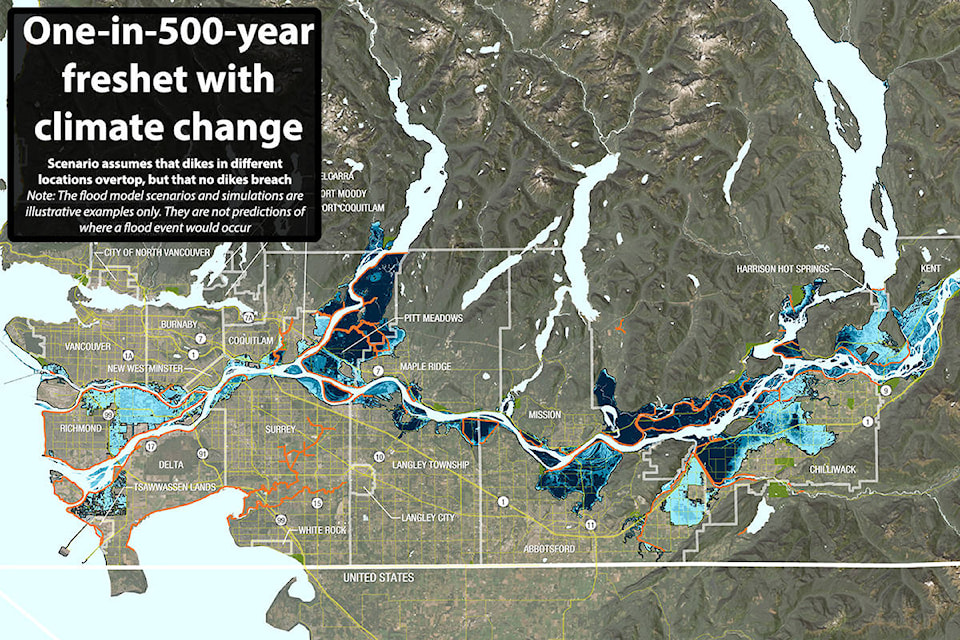Harrison council spent much of Tuesday night looking at how the village can prepare for possible future floods.
During the meeting Tuesday (Feb. 16), council addressed three separate flooding-related items, including a delegation from the Fraser Basin Council, a letter from the District of Kent and a motion to apply for grant funding for a flood risk assessment.
Council voted to approve a grant application of up to $150,000 to the Community Emergency Preparedness Fund that would allow the village to conduct a flood risk assessment.
RELATED: MAP: Climate change will increase flooding risk in Chilliwack & Abbotsford
According to operations manager Tyson Koch, the village had applied for a grant to upgrade the road up to the wastewater treatment plant in 2020 but that application was denied.
The UBCM program officer told the village that the project did have merit, but the province wanted to see new flooding-related information on the dike, treatment plant access road and other areas. The village was encouraged to apply for grant funding to conduct a flood risk assessment, which would strengthen future grant applications in this area.
The village is currently working with Northwest Hydraulic Consultants to prepare its application for the grant funding, and that company would be contracted to complete the flood risk assessment if the grant was approved.
The District of Kent is currently working with Northwest Hydraulics for an assessment of their own flood risk, and the creation of a mitigation plan that create recommendations for areas of high flood risk.
The district sent a letter to Harrison council asking for their support in providing input to this assessment and plan, as flooding on the Fraser and Harrison rivers is a shared concern and a regional survey will help create regional recommendations. Harrison council voted unanimously to send a letter of support to the district.
In addition to local flooding concerns, the village also heard a delegation from Steve Litke from the Fraser Basin Council on the second draft of its Lower Mainland Flood Management Strategy.
RELATED: Two decades of flood planning useless without money, Abbotsford mayor says
The Flood Management Strategy is a regional look at flood risk in the Lower Mainland, and aims to create an organization to manage regional concerns, as well as help advise on funding decisions and provide support for local flood planning. The planning for this organization is still in the early stages, and local governments are being invited to share their input on the strategy.
After the delegation, Harrison councillors asked Litke about some of the local impacts the Fraser Basin Council had noted in the preparation of their strategy.
Coun. Michie Vidal asked about the state of the village’s dikes. Across the Lower Mainland, Litke had said, dikes are not meeting provincial standards, according to a review of reports from various local governments.
Vidal noted that the villages dikes are rated around a two or 2.5 out of four, which caused her concern as the wastewater treatment plant is on part of the dike, and it had potential to be in jeopardy. Litke said that a field-evaluation of the dike system, like the one the village will undertake if its grant application is successful, would help to get a better understanding of the current dike system.
RELATED: Valley dikes too low to withstand major Fraser River flood
Coun. Ray Hooper also asked some specific questions about the Lower Mainland strategy, including whether certain areas would be “sacrificed” in a flood event, how dredging would impact water levels and whether farmers would be compensated if dikes were moved further from the river’s edge.
Litke said that even if an area was flooded due to dike failures, it would only have a minor and temporary impact on water levels. He also noted that significant dredging — lowering the gravel bars at the Agassiz-Rosedale Bridge by two metres, for example — would only lower the water level by 12 centimetres. Moving the dikes back from the river was a possibility in some areas, and property owners would be compensated, but the impact again would be small on the river’s water levels.
He said the flood management strategy was instead looking at a variety of different ways the region can control flood risk, saying that there was “no silver bullet” for the region as a whole.
news@ahobserver.com
Like us on Facebook and follow us on Twitter
